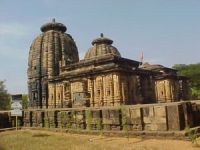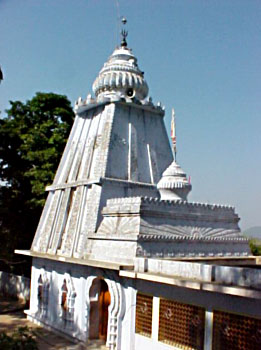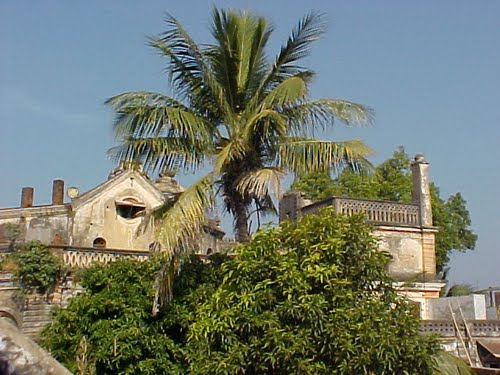
Ramnath :
A group of three temples of Siva at Boudh town called the Rameswar or Ramanath
temples , dating back to the 9th century A.D. are reputed for their special
feature.
The decorative motifs and the plastic art of three temples at Boudh are
certainly superior to and older than the great lingaraj-Ananta –Vasudeva group.
One particular feature of the Ramanath temple is worth particular attention.
Their plan is quite different from any other temples. In plan these temples are
eight-rayed stars and the argha-pattas of the lingas are also similar.These
magnificent temples built of red sandstone and profusely carved are stated to
have been constructed in mid-ninth century A.D. The temples with rich texture
and curved surfaces are strikingly noteworthy. Each of these temples stands by
itself on a raised platform and each consists of a cell and an attached portico.
The minute recesses and angularities produce a charming effect of light and
shade and confer an appearance of greater height from the continued cluster of
vertical lines than they really possess. Archeological Survey of India has
preserved this temple.

Jagati :
Jagati is situated at a distance of 16 Km. from Boudh . Near the village at
Gandhradi, is situated the famous twin temples of Nilamadhava and Sidheswar.
These temples were constructed under the patronage of the Bhanja rulers of
Khinjali mandala in 9th century A.D. These two temples were built on one
platform which are exactly similar to each other. The one on the left hand is
dedicated to Siva named Siddheswar and its sikhara is surmounted by a
Sivalinga.The second is dedicated to Vishnu ,named Nilamadhava and its sikhara
is surmounted by a wheel of blue chlorite. The principle of construction of the
Jagamohanas at gandharadi is slightlt different than that of other temples.
Their roofs are built on the cantilever principle and originally it appears to
have been supported on twelve large pillars arranged as a hollow square .
Thus each side had four pillars of which the central ones flanked an opening.
Originally these two Jagamohanas appear to have been open on all sides; but
later on the lintels on all sides appear to have given away and then it became
necessary to fill in the gaps between pillars with the exception of the four
openings with ashlar masonry. At the same time the side openings were filled up
with a jali or lattice of blue chlorite towards the bottom and a frieze of four
miniature temple sikharas over it. This arrangement is not followed in later
temples where the ingress of light into jagamohana is through four or five stone
pillars in the opening used as window bars.
The style of ornamentation in the jagamohans of the Gandharadi temples is
altogether different. Even stylized chaitya-windows are rarely to be seen at
Gandharadi except at the bases of the pilasters of the vimana . the
ornamentation on these two jagamohans is very simple and much less overcrowded .
The importance of the Gandharadi temples lies in the fact that they provide a
link and that a very important one, in the chain of the evolution ,in the chain
of the evolution of the mediaeval Orissan temple type.
The Gandharadi temple is also locally known as ‘Chari Sambhu Mandira ‘ ( the
temple of four Sambhus or Siva lingas). In the Siva temple Siddheswar is the
presiding deity. In the Jagamohan ,to the left of the door leading to the
sanctum is the siva Linga called Jogeswar and to the right of the door is the
linga called Kapileswar. At a little distance from Siddheswar standsa the
temples of Paschima Somanath ( Siva), the door of the temple opening to the
west.
Some images of considerably antiquity are found worshipped in shrines nearby.
Notable among them are the images of Ganesh in the temple of Paschima somanath
and a beautiful image of eight armed Durga worshipped under a banyan tree,the
later image being badly eroded due to the vagaries of weather. These images
probably once adorned the siddheswar temple .Portions of beautifully carved door
steps in black chlorite and other decorative motifs have been unearthed. In the
vicinity of the temple. A five feet (1.52 meters) high Hanuman image of good
workmanship is being worshipped near the village Jagati and a beautiful carved
Nabagraha slab is lying in the cornfield. Archeological Survey of India has
preserved this place. .

Rameswar or Ramanath temples :
Rameswar or Ramanath temples, dating back to the 9th century A.D. The decorative
motifs and the plastic art of three temples at Boudh are certainly superior to
and older than the great Lingaraja -Ananta -Vasudeva group. Their plan is quite
different from any other temples. In plan these temples are eight-rayed stars
and the Argha-Pattas of the Lingas are also similar. These magnificent temples
were built of red sandstone and profusely carved. The temples with rich texture
and curved surfaces are strikingly noteworthy.

This is the palace of ex-Ruler of Boudh locally known as Rajabati. This was
constructed during the reign of Raja Jogindra Dev ,who was benevolent and
generous ruler. The palace is a picturesque and handsome building commanding a
fine view of Mahanadi.
|



